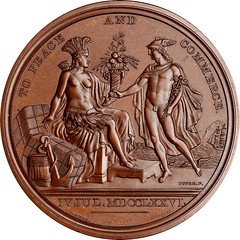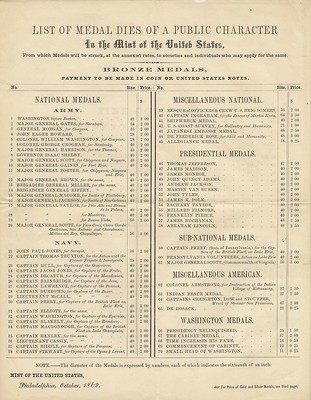
PREV ARTICLE
NEXT ARTICLE
FULL ISSUE
PREV FULL ISSUE
V25 2022 INDEX E-SYLUM ARCHIVE VOCABULARY TERM: LIST MEDALHere's another entry from Dick Johnson's Encyclopedia of Coin and Medal Terminology. I added images of a Diplomatic Medal and an 1862 U.S. Mint medal price list from my numismatic ephemera collection. -Editor
List medals are struck in bronze from dies prepared by the engraving staff at the U.S. Mint at Philadelphia. Several medal series are included, as U.S. Presidents, Secretaries of the Treasury, Mint Directors, Army and Navy medals, U.S. Mint buildings and such. Some collectors consider these medals restrikes – only those first issued near the time of their creation can be considered originals, they say. However, since these medals were issued by the U.S. Mint they are still considered official, despite their availability, some for nearly two hundred year's time. (In strict numismatic terminology, these medals are reissues, not restrikes.) List medals range up to 3-inch size – some in the Indian Peace series are oval shaped – but beginning in 1971 a number of the medals were issued in 1 5/16-inch diameter. These mini medals are struck on coining presses in coin relief and are produced at two U.S. Mints, Denver and Philadelphia (they even bear mintmarks). The U.S. President series, U.S. Mint buildings and others are available in this miniature size also. The purpose of these smaller medals – at lower cost – were intended for children.
History of List medals. Historically the U.S. Mint sold medals of a national interest to the public just prior to the Civil War. As demand for such items as Washington and Lincoln medals grew, the mint supplied these. The subject of the medals issued in the first century of the mint's existence are covered in the book, Medals of the United States Mint, 1792–1892 by Robert W. Julian. Of the 573 medals listed as products of the Mint's first century, 123 became list medals. Julian notes the earliest use of the term "list" medals and defines it as: "From this period on [1861], all national medals available for purchase by the public, and sold by the mint, were publicized by printed lists, hence the name." This appeared in the introduction (page 27) of his Medals of the United States Mint, 1792–1892. Today no private medals can be struck at the U.S. Mint without authorization of Congress. But for much of our country's history private issues have been struck there for the reason that production facilities for striking large medals simply did not exist in America outside the U.S. Mint. A private medal industry, born of the Columbian Exposition of 1892, began to grow in size. By 1910 it had the facilities to produce a medal of most any size and by 1935 it began urging the federal government to get out of the private medal business. However, it was not until 1948 that the last private medal was struck at the Philadelphia Mint. (See private issue.) While list medals include only those medals authorized to be sold to the public, the government does have a policy of making available bronze copies of gold medals presented to deserving Americans (and a few foreigners) authorized by Congress. Thus anyone can purchase these congressional medals in original 3-inch size struck in bronze. These include, for example, of the Jonas E. Salk Medal that the inventor of the Salk vaccine received in gold, or the entertainer Bob Hope. This egalitarian policy has existed for over a century and is in line with democratic principles of equality in America. Beginning in 1984, however, the U.S. Mint began a program to reduce the number of list medals available for sale. In the first edition of the 1969 catalog 188 medals were available for public purchase. In the following 15 years this number had risen to over 210. Mint authorities felt, regretfully, it was impractical to continue to supply this many medals since some sold only a few each year. Thus an austerity program, launched in 1984, led to the phasing out of less popular medals with no plans to replace or inventory these medals. In the end the unsold inventory of list medals were sold in grab bags! This marked, somewhat, a low point in the U.S. Mint's respect for the significance and heritage of these national medallic treasures. Need for cataloging List Medals. Over the years some of the list medals were issued in several varieties, a different reverse design (as for a second term, say), signed and unsigned varieties, and such. These are all of vital interest to numismatists but for the most part this information remains uncataloged and unpublished.
References:
To read the complete entry on the Newman Numismatic Portal, see:
Wayne Homren, Editor The Numismatic Bibliomania Society is a non-profit organization promoting numismatic literature. See our web site at coinbooks.org. To submit items for publication in The E-Sylum, write to the Editor at this address: whomren@gmail.com To subscribe go to: https://my.binhost.com/lists/listinfo/esylum All Rights Reserved. NBS Home Page Contact the NBS webmaster 
|


